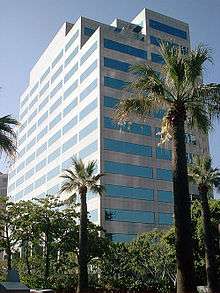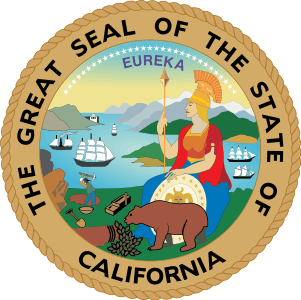Glendale, California
Glendale /ˈɡlɛndeɪl/ is a city in Los Angeles County, California, United States. As of the 2010 census it had a population of 191,719,[10] and in 2018 the population was estimated at 201,361,[8] making it the fourth-largest city in Los Angeles County and the 23rd-largest city in California. It is located about 10 miles (16 km) north of downtown Los Angeles.
Glendale, California | |
|---|---|
City | |
| City of Glendale | |
 View of Glendale from Forest Lawn Memorial Park | |
 Flag  Seal | |
| Nickname(s): The Jewel City | |
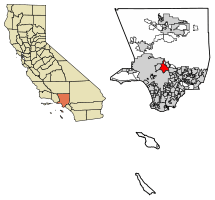 Location of Glendale in Los Angeles County, California. | |
 Glendale, California Location in the United States | |
| Coordinates: 34°08′46″N 118°15′18″W | |
| Country | |
| State | |
| County | |
| Incorporated | February 15, 1906[1] |
| Government | |
| • Type | Council-Manager[2] |
| • City council[2] | Mayor Ara Najarian Zareh Sinanyan Vartan Gharpetian Paula Devine Vrej Agajanian |
| • City treasurer | Rafi Manoukian[3] |
| • City Manager | Yasmin Beers[4] |
| Area | |
| • Total | 30.56 sq mi (79.16 km2) |
| • Land | 30.43 sq mi (78.82 km2) |
| • Water | 0.13 sq mi (0.34 km2) 0.43% |
| Elevation | 522 ft (159 m) |
| Population | |
| • Total | 191,719 |
| • Estimate (2018)[8] | 201,361 |
| • Rank | 4th in Los Angeles County 23rd in California US: 112th |
| • Density | 6,672.82/sq mi (2,576.17/km2) |
| Time zone | UTC−8 (Pacific) |
| • Summer (DST) | UTC−7 (PDT) |
| ZIP codes[9] | 91201–91210, 91214, 91221, 91222, 91224–91226 |
| Area code | 747 and 818 |
| FIPS code | 06-30000 |
| GNIS feature IDs | 1660679, 2410597 |
| Website | glendaleca |
Glendale lies in the southeastern end of the San Fernando Valley, bisected by the Verdugo Mountains, and is a suburb in the Los Angeles metropolitan area. The city is bordered to the northwest by the Sun Valley and Tujunga neighborhoods of Los Angeles; to the northeast by La Cañada Flintridge and the unincorporated area of La Crescenta; to the west by Burbank and Griffith Park; to the east by Eagle Rock and Pasadena; to the south by the Atwater Village neighborhood of Los Angeles; and to the southeast by Glassell Park neighborhood of Los Angeles. The Golden State, Ventura, Glendale, and Foothill freeways run through the city.
History
Origins
The area was long inhabited by the Tongva people (or "People of the Earth"), who were later renamed the Gabrieleños by the Spanish missionaries, after the nearby Mission San Gabriel Arcángel.
In 1798, José María Verdugo, a corporal in the Spanish army from Baja California, received the Rancho San Rafael from Governor Diego de Borica, formalizing his possession and use of land on which he had been grazing livestock and farming since 1784. Rancho San Rafael was a Spanish concession, of which 25 were made in California. Unlike the later Mexican land grants, the concessions were similar to grazing permits, with the title remaining with the Spanish crown.[11]

In 1860, his grandson Teodoro Verdugo built the Catalina Verdugo Adobe, which is the oldest building in Glendale. The property is the location of the Oak of Peace, where early Californio leaders including Pio Pico met in 1847 and decided to surrender to Lieutenant Colonel John C. Frémont.
Verdugo's descendants sold the ranch in various parcels, some of which are included in present-day Atwater Village, Eagle Rock, and Highland Park neighborhoods of Los Angeles.
In 1884, residents gathered to form a townsite and chose the name "Glendale" (it was bounded by First Street (now Lexington Drive) on the north, Fifth Street (now Harvard Street) on the south, Central Avenue on the west, and the Childs Tract on the east.[12] Residents to the southwest formed "Tropico" in 1887.
The Pacific Electric Railway brought streetcar service in 1904.
Post incorporation
Glendale incorporated in 1906, and annexed Tropico 12 years later. An important civic booster of the era was Leslie Coombs Brand (1859–1925), who built an estate in 1904 called El Miradero, featuring an eye-catching mansion, the architecture of which combined characteristics of Spanish, Moorish, and Indian styles, copied from the East Indian Pavilion at the 1893 World's Columbian Exposition held in Chicago, which he visited. Brand loved to fly, and built a private airstrip in 1919 and hosted "fly-in" parties, providing a direct link to the soon-to-be-built nearby Grand Central Airport. The grounds of El Miradero are now city-owned Brand Park and the mansion is the Brand Library, according to the terms of his will.[13] Brand partnered with Henry E. Huntington to bring the Pacific Electric Railway, or the "Red Cars", to the area. Today, he is memorialized by one of the city's main thoroughfares, Brand Boulevard.
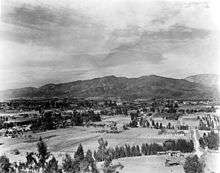

The city's population rose from 13,756 in 1920 to 62,736 in 1930. The Forest Lawn Cemetery opened in 1906 and was renamed Forest Lawn Memorial-Park[14] in 1917. Pioneering endocrinologist and entrepreneur Henry R. Harrower opened his clinic in Glendale in 1920, which for many years was the largest business in the city. The American Green Cross, an early conservation and tree preservation society, was formed in 1926 (it disbanded three years later and the current organization of that name is unrelated).
Grand Central Airport was the departure point for the first commercial west-to-east transcontinental flight flown by Charles Lindbergh.
Until as late as the 1960s, Glendale was a sundown town. Nonwhites were required to leave city limits by a certain time each day or risk arrest and possible violence. In the 1930s, Glendale and Burbank prevented the Civilian Conservation Corps from stationing African American workers in a local park, citing sundown town ordinances that both cities had adopted.[15] In 1964, Glendale was selected by George Lincoln Rockwell to be the West Coast headquarters of the American Nazi Party. Its offices, on Colorado Street in the downtown section of the city, remained open until the early 1980s.
Historic architecture
Glendale began its historic preservation program in 1977 with the designation of 28 properties as city landmarks. In 1997, the program evolved with the establishment of the Glendale Register of Historic Resources. The register now has over 100 properties. In addition, 11 properties in Glendale are listed on the National Register of Historic Places. The city's most honored historic properties include the Catalina Verdugo Adobe, Brand Library & Art Center, Glendale Southern Pacific Railroad Depot, Grand Central Air Terminal, and Alex Theatre.
Geography
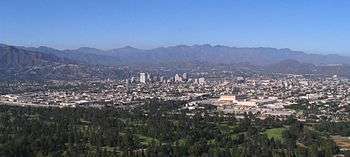
Glendale is located at the junction of two large valleys, the San Fernando and the San Gabriel. According to the United States Census Bureau, the city has a total area of 79.212 km2 (30.6 sq mi); 30.5 square miles (79 km2) of it is land and 0.13 square miles (0.34 km2) of it (0.43%) is covered by water. It is bordered to the north by the foothill communities of La Cañada Flintridge, La Crescenta, and Tujunga; to the south by the Atwater Village and Glassell Park communities incorporated by the city of Los Angeles; to the east by Pasadena and Eagle Rock (also incorporated within Los Angeles); and to the west by the city of Burbank. Glendale is located 10 miles (16 km) north of downtown Los Angeles.[16]
Geology
Several known earthquake faults criss-cross the Glendale area and adjacent mountains, as in much of Southern California. Among the more recognized faults are the Sierra Madre and Hollywood faults, situated in the city's northern and southwestern portions, respectively. Additionally, the Verdugo and Raymond faults intersect through the city's central and southeastern areas. The San Gabriel fault, meanwhile, is located northeast of the city. Roughly 75 miles (121 km) northeast of Glendale is a major portion of the San Andreas Fault known as the "Big Bend", where quake-recurrence tracking shows major activity roughly every 140–160 years. The closest portion of the San Andreas is actually 29 miles (47 km) from Glendale. The last major quake along the southern San Andreas was recorded in 1857.
In the 1971 San Fernando earthquake, which took place along the western edge of the Sierra Madre Fault, surface ruptures were nearly 12 miles (19 km) long, including one portion a few miles northwest of Glendale. Most of the damage was in the northern San Fernando Valley, though 31 structures in Glendale suffered major damage and had to be demolished, plus numerous chimneys collapsed. The 1994 Northridge earthquake had an epicenter about 18 miles (29 km) from Glendale. The city suffered severe damage to a public parking structure and sections of the Glendale Galleria parking structures and exterior columns incurred damages.[17]
Climate
Glendale has a Mediterranean climate (Köppen climate classification Csa), with hot summers and mild, damp winters. The highest recorded temperature in Glendale was 110 °F (43 °C) on several occasions. The lowest recorded temperature was 17 °F (−8 °C) in February 2003. The warmest month is August and the coolest month is January.
The annual average precipitation is just over 21 inches, mostly falling between November and April. Rainfall totals are highly variable from year to year, with the wettest years (sometimes over 30 inches of rainfall) usually associated with warm El Nino conditions, and the drier years (sometimes under 10 inches) with cool La Nina episodes in the Pacific.
The hills and mountains of northern Glendale very rarely have snow, owing to its warmer temperatures during the winter. It may only occur about every five to 10 years. The last time it snowed was February 26, 2011 in which snow accumulation of approximately 3" occurred and sleet was present. Frost sometimes occurs at night from late November to early March. Heavy rains and thunderstorms are also common during the winter. The spring brings pleasant weather, with very little rain. The summer is usually fairly warm, with highs from 85 °F (29 °C), to the low 100s (40 °C). The highest temperature ever recorded was 110 °F (43 °C). Summer can sometimes bring monsoon thunderstorms. Humidity can be very low, but it can also be very high, causing very steamy, muggy, and uncomfortable conditions. These days cause heat indices over 120 °F (49 °C). Fall brings nice weather, but can be gusty due to the Santa Ana winds, blowing in once or twice a year from October to December. Santa Ana winds can reach up to 70 miles per hour, with gusts up to 100 in mountain passes and canyons. Thunderstorms occur very rarely and they are accompanied by gusty winds and hail.[18]
| Climate data for Glendale, California | |||||||||||||
|---|---|---|---|---|---|---|---|---|---|---|---|---|---|
| Month | Jan | Feb | Mar | Apr | May | Jun | Jul | Aug | Sep | Oct | Nov | Dec | Year |
| Record high °F (°C) | 93 (34) |
92 (33) |
96 (36) |
105 (41) |
102 (39) |
110 (43) |
110 (43) |
107 (42) |
110 (43) |
108 (42) |
98 (37) |
93 (34) |
110 (43) |
| Average high °F (°C) | 68 (20) |
70 (21) |
71 (22) |
76 (24) |
78 (26) |
84 (29) |
89 (32) |
91 (33) |
89 (32) |
83 (28) |
74 (23) |
68 (20) |
78 (26) |
| Average low °F (°C) | 44 (7) |
46 (8) |
47 (8) |
50 (10) |
53 (12) |
57 (14) |
61 (16) |
62 (17) |
61 (16) |
55 (13) |
48 (9) |
44 (7) |
52 (11) |
| Record low °F (°C) | 23 (−5) |
17 (−8) |
23 (−5) |
34 (1) |
37 (3) |
41 (5) |
45 (7) |
48 (9) |
44 (7) |
37 (3) |
29 (−2) |
26 (−3) |
17 (−8) |
| Average precipitation inches (mm) | 4.48 (114) |
5.00 (127) |
4.38 (111) |
1.22 (31) |
0.45 (11) |
0.21 (5.3) |
0.05 (1.3) |
0.21 (5.3) |
0.48 (12) |
0.65 (17) |
1.50 (38) |
2.46 (62) |
21.09 (534.9) |
| Source: [19] | |||||||||||||
Parks
The city has nearly 50 public parks, from Deukmejian Wilderness Park in the north to Cerritos Park in the south.[20] Central Park has the only West Coast monument to Korean comfort women of World War II.[21]
Economy
As of 2016, the top employers in the city are (with number of employees):[22]
| # | Employer | # of Employees |
|---|---|---|
| 1 | Glendale Adventist Medical Center | 2,662 |
| 2 | Glendale Unified School District | 2,460 |
| 3 | City of Glendale | 1,997 |
| 4 | Dreamworks Animation | 1,478 1 |
| 5 | Glenair Inc. | 1,322 |
| 6 | Nestle Company | 1,275 |
| 7 | Glendale Community College | 1,242 |
| 8 | Glendale Memorial Medical Center | 1,200 |
| 9 | USC Verdugo Hills Hospital | 726 |
| 10 | Public Storage | 354 |
NOTES:
- 1 Employee count is from FY2014, current data is unavailable.
Industry and development
Grand Central Airport was a municipal airport developed from 1923 which became the largest employer in Glendale for many years, and contributed to the development of aviation in the United States in many important ways. The main terminal building still stands and includes both Art Deco and Spanish-style architectural elements. The facility was the first official terminal for the Los Angeles area, as well as the departure point for the first commercial west-to-east transcontinental flight flown by Charles Lindbergh. During World War II, the Grand Central Air Terminal building was camouflaged to protect it from enemy targeting. It was closed down in 1959, and made way for the Grand Central Business Centre, an industrial park.
Forest Lawn Memorial Park started in Tropico (later annexed to Glendale) in 1906 and is famous for its art collection and the burial of many celebrities, as well as for the 1933 opening of the first funeral home on cemetery grounds anywhere in the United States.[23] The Bob's Big Boy chain of hamburger restaurants started in Glendale on East Colorado in August 1936, and the Baskin-Robbins "31 Flavors" chain of ice cream parlors started in Adams Square in 1945. The Glendale Public Library[24] on Harvard Street houses its "Special Collections" department which contains original documents and records on much of the history of Glendale. It also contains one of the largest collections of books on cats in the world, over 20,000 volumes.[25] It was donated to the library in the 1950s by the Jewel City Cat Fanciers Club.
The city experienced significant development in the 1970s, with the completion of the Glendale Freeway (Highway 2) and the Ventura Freeway (Highway 134). This included redevelopment of Brand Boulevard, renovation of the 1925 Alex Theatre, and construction of the Glendale Galleria shopping mall which opened in 1976, and was further expanded in 1982.
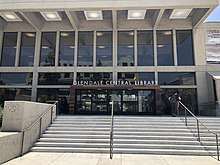
Several large companies have offices in Glendale including the U.S. headquarters of International House of Pancakes. The Los Angeles regional office of California's State Compensation Insurance Fund is in Glendale. Americas United Bank was founded in Glendale in 2006 and is still headquartered there. In August 2013, Avery Dennison Corp., a label maker for major brands, announced plans to move its headquarters from Pasadena to Glendale.[26] Avery employs about 26,000 people. The U.S. headquarters of the Swiss foods multinational Nestlé plans to move out by 2018.[27]
Glendale, along with Burbank, has served as a major production center for the U.S. entertainment industry and the U.S. animation industry in particular for several decades, because the Walt Disney Company outgrew its Burbank studio lot in the early 1960s, and started expanding into the closest business park available, which happened to be Glendale's Grand Central Business Centre about two miles east. First came the headquarters for Imagineering, followed in the 1980s by other divisions and offices. Today, Disney's Grand Central Creative Campus (known as GC3 for short) is home to Consumer Products, Disney Interactive, the Muppets Studio, and Marvel Animation Studios.[28] From 1985 to 1995, Walt Disney Animation Studios (then known as Walt Disney Feature Animation) was headquartered in the Grand Central Business Centre, meaning that most of the films of the Disney Renaissance era were actually developed in Glendale. DisneyToon Studios, a division of WDAS, is still located in the Grand Central Business Centre near GC3, along with the Animation Research Library, Disney Animation's archive. Disney-owned KABC-TV is located on Circle 7 Drive to the south of GC3.
In 1994, Steven Spielberg, Jeffrey Katzenberg, and David Geffen formed DreamWorks SKG, a diversified entertainment company. DreamWorks Animation remains located in the city's Grand Central Business Centre on land formerly occupied by a helicopter landing base next to the old airfield (and next to KABC-TV). Thus, many American animators who worked on feature films in the 1990s and 2000s have spent large portions of their careers in Glendale working for Disney or DreamWorks.
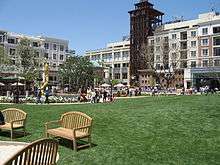
In 2005, construction began near the Galleria of developer Rick Caruso's "Americana at Brand", a 15.5-acre (63,000 m2) outdoor shopping and residential community. Caruso had previously designed and built the Grove at Farmers Market. The new Glendale development was opened to the public on May 2, 2008, and features 75 shops and restaurants, 238 apartments, 100 condominiums, and a Pacific Theatres 18-plex Cinema which seats 3000 people.[29]
Shopping
The downtown Glendale Galleria is anchored by Macy's, Target, J. C. Penney, and Bloomingdales, and the Americana at Brand, an outdoor mall which includes stores such as Tiffany & Co., H&M, Armani Exchange, True Religion, and Urban Outfitters.[30] The Americana at Brand is home to a Nordstrom, which was previously located inside the Glendale Galleria. Another shopping area is the Glendale Fashion Center, which is anchored by Ross, TJ Maxx, Nordstrom Rack, Staples, and Petco.
Demographics
| Historical population | |||
|---|---|---|---|
| Census | Pop. | %± | |
| 1910 | 2,746 | — | |
| 1920 | 13,536 | 392.9% | |
| 1930 | 62,736 | 363.5% | |
| 1940 | 82,582 | 31.6% | |
| 1950 | 95,702 | 15.9% | |
| 1960 | 119,442 | 24.8% | |
| 1970 | 132,664 | 11.1% | |
| 1980 | 139,060 | 4.8% | |
| 1990 | 180,038 | 29.5% | |
| 2000 | 194,973 | 8.3% | |
| 2010 | 191,719 | −1.7% | |
| Est. 2018 | 201,361 | [8] | 5.0% |
| U.S. Decennial Census[31] | |||
2010
The 2010 United States Census[32] reported that Glendale had a population of 191,719. According to the Southern California Association of Government's 2016 Demographic and Growth Forecast, the population of Glendale is expected to reach about 214,000 by 2040, an increase of about 11 percent from 2012.[33] The population density was 6,268.6 people per square mile (2,420.3/km²). The racial makeup of Glendale was 136,226 (71.1%) White, 2,573 (1.3%) Black, 531 (0.3%) Native American, 31,434 (16.4%) Asian (6.9% Filipino, 5.4% Korean, 1.3% Chinese), 122 (0.1%) Pacific Islander, 12,146 (6.3%) from other races, and 8,687 (4.5%) from two or more races. Hispanics or Latinos of any race were 33,414 persons (17.4%). Non-Hispanic Whites were 61.5% of the population.[7]
The census reported that 190,290 people (99.3% of the population) lived in households, 223 (0.1%) lived in noninstitutionalized group quarters, and 1,206 (0.6%) were institutionalized. Of the 72,269 households, 21,792 (30.2%) had children under the age of 18 living in them, 37,486 (51.9%) were opposite-sex married couples living together, 8,908 (12.3%) had a female householder with no husband present, 3,693 (5.1%) had a male householder with no wife present, 2,359 (3.3%) were unmarried opposite-sex partnerships, and 605 (0.8%) were same-sex married couples or partnerships. About 18,000 households (24.9%) were made up of individuals, and 7,077 (9.8%) had someone living alone who was 65 years of age or older. The average household size was 2.63. The 50,087 families (69.3% of all households) had an average family size of 3.19.
In the city, the population was distributed as 35,732 (18.6%) under the age of 18, 16,609 (8.7%) aged 18 to 24, 54,518 (28.4%) aged 25 to 44, 54,942 (28.7%) aged 45 to 64, and 29,918 (15.6%) who were 65 years of age or older. The median age was 41.0 years. For every 100 females, there were 91.1 males. For every 100 females age 18 and over, there were 87.9 males.
The 76,269 housing units averaged 2,493.8 per square mile (962.8/km²), of which 27,535 (38.1%) were owner-occupied, and 44,734 (61.9%) were occupied by renters. The homeowner vacancy rate was 1.3%; the rental vacancy rate was 5.5%; 76,769 people (40.0% of the population) lived in owner-occupied housing units and 113,521 people (59.2%) lived in rental housing units.
During 2009–2013, Glendale had a median household income of $53,020, with 14.2% of the population living below the federal poverty line.[7]
2000
As of the census[34] of 2000, there were 194,973 people, 71,805 households, and 49,617 families residing in the city. The population density was 6,362.2 inhabitants per square mile (2,456.1/km²). There were 73,713 housing units averaged 2,405.3 per square mile (928.6/km²). The racial makeup of the city was 63.6% White, 1.6% Black, 0.3% Native American, 16.1% Asian American, 0.1% Pacific Islander, 8.6% from other races, and 10.1% from two or more races. About 19.7% of the population was Hispanic or Latino of any race.
Of the 71,805 households, 32.9% had children under the age of 18 living with them, 52.3% were married couples living together, 11.8% had a female householder with no husband present, and 30.9% were not families; 25.7% of all households were made up of individuals and 8.7% had someone living alone who was 65 years of age or older. The average household size was 2.68 and the average family size was 3.27.
In the city, the population was distributed as 22.4% under the age of 18, 8.4% from 18 to 24, 32.2% from 25 to 44, 23.1% from 45 to 64, and 13.9% who were 65 years of age or older. The median age was 38 years. For every 100 females, there were 91.3 males. For every 100 females age 18 and over, there were 88.0 males.
The median income for a household in the city was $41,805, and for a family was $47,633. Males had a median income of $39,709 versus $33,815 for females. The per capita income for the city was $22,227. About 13.6% of families and 15.5% of the population were below the poverty line, including 20.7% of those under age 18 and 11.9% of those age 65 or over.
In June 2000, Erin Texeira of the Los Angeles Times stated that according to data from the US Census and the City of Glendale, the populations were about 30% Armenians, 25% other White, 25% Latino and Hispanic, and 16% Asian.[16]
Armenian population
Glendale has one of the largest communities of Armenian descent in the United States.[35]
Armenian families have lived in the city since the 1920s, but the surge in immigration escalated in the 1970s. Armenian Americans are well integrated into the city, with many businesses, several Armenian schools, and ethnic/cultural organizations serving this ethnic group. Most of the Armenians in Glendale arrived in the city in the past two decades.[36] The city of Glendale is home to one of the largest Armenian communities outside of Armenia.
Beginning in the late 1980s, with assistance from family and friends already there, Armenians from the former Soviet Union began arriving.[16] In the Glendale Unified School District, by 1988, along with students from the Middle East, they had become the largest ethnic group in the public schools, now having a larger number than the Latinos.[37] Glendale became the municipality with the largest number of ethnic Armenians outside of Yerevan, Armenia. In 2014, a Glendale Police Department spokesperson, stated, "In five to eight years, the [Armenian] community went from a few thousand to about 40,000."[16] Levon Marashlian, an instructor of Armenian history at Glendale College, stated that in the early 1990s Glendale's Armenian community became the largest in the Los Angeles metropolitan area, surpassing the Armenian community of Hollywood.[16] Alice Petrossian, the GUSD director of intercultural education, stated that Burbank lies within the middle of other Armenian communities, so it attracted Armenians.[37] There are also a great number of Armenian immigrants from Iran who, due to the religious restrictions and lifestyle limitations of the Islamic government, immigrated to the US, many to Glendale since it was where their relatives resided.
A new headquarters of the Armenian National Committee/Western Region opened in 1994.[38] By 1999, about 25% of the population spoke Armenian and there were many Armenian businesses.[39] By 2005 the Armenian population was 40% of the total population.[40]
According to the United States 2000 Census, Glendale is home to 65,343 Armenian-Americans[41] (making up 34.1% of the total population), increasing from 1990 when there were 31,402 Armenian-Americans in the city.[42] As of 2005, one-third of Los Angeles' estimated 153,000 Armenians, or 51,000 around a quarter of Glendale's 205,000 residents was Armenian. At that time, Armenians held a majority on the Glendale city council,[43] and it had done so since that year.[40]
As of March 2018, four of the five members of Glendale's city council are of Armenian descent: Mayor Vartan Gharapetian and councilmembers Zareh Sinanyan (mayor from 2014–15), Ara Najarian (mayor from 2007–08, 2010–11, and 2015–16), and Vrej Agajanian. Former Armenian-American mayors of Glendale include Larry Zarian, Bob Yousefian, and Rafi Manoukian.
Singer Serj Tankian and bassist Shavo Odadjian, members of the Armenian-American rock band System of a Down, were based in Glendale at the time of formation.
The Cathedral of Saint Gregory the Illuminator, which is the seat of North American diocese of the Armenian Catholic Church, is located in Glendale. The Bishop of the Diocese, Rt. Rev. Mikaël Antoine Mouradian, is also resident in Glendale.
Other ethnic groups
The Mexican American community was established in Glendale by the 1960s. The late 1980s and the early 1990s also saw increases in Mexican American population as Glendale offers a safer suburban environment away from the city with higher quality education.[16] As of 2012, Filipino Americans were the third largest minority group in Glendale, making up seven percent of the city's total population, overtaking Korean Americans.[44] After the Iranian Revolution, many Persians migrated to the cities seeking a suburban city with lower crime and quality education.[45]
Crime and public safety
In 1977 and 1978, 10 murdered women were found in and around Glendale in what became known as the case of the Hillside Strangler. The murders were the work of Kenneth Bianchi and Angelo Buono, the latter of whom resided at 703 East Colorado Street, where most of the murders took place.[46]
In 2014, Glendale was named the ninth-safest city in America in a report published by 24/7 Wall Street based on violent crime rates in cities with more than 100,000 people.[47] Also in 2014, real estate company Movoto used FBI data crime data from 2013 to conduct a study of 100 U.S. cities with populations between 126,047 and 210,309 residents and concluded that Glendale was the safest mid-sized city in America.[48]
The street gang Armenian Power, which is closely allied with the Mexican Mafia prison gang, is active in Glendale.
Government
Local government
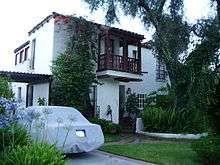
According to the city's most recent comprehensive annual financial report, the city's various funds had $576 million in revenues, $543 million in expenditures, $2,090 million in total assets, $481 million in total liabilities, and $460 million in cash and investments.[49] Glendale elects its City Council members at large, to a four-year term. Elections are held on a Tuesday after the first Monday in April of odd-numbered years along with the Glendale Unified School District Board of Education and the Glendale Community College District Board of Trustees.
County representation
The Los Angeles County Department of Health Services operates the Glendale Health Center in Glendale.[50]
State and federal representation
In the United States House of Representatives, Glendale is in California's 28th congressional district, represented by Democrat Adam Schiff.[51]
In the California State Legislature, Glendale is in the 25th Senate District, represented by Democrat Anthony Portantino, and in the 43rd Assembly District, represented by Democrat Laura Friedman.[52]
Law enforcement and services
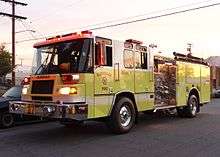
Glendale maintains its own police department (GPD), which operates from a main station in downtown Glendale, a downtown substation in the Glendale Galleria, and the Montrose substation in Verdugo City. Glendale Community College also operates its own police department (GCCPD). The California Highway Patrol has its Southern Division Headquarters on Central Avenue in downtown Glendale.
Fire department
Fire protection is provided by the Glendale Fire Department (GFD). The GFD is an all-risk, career fire protection agency, responding to about 17,000 emergency and nonemergency calls for service annually.[53] The GFD consists of nine strategically located fire stations, with mutual aid provided by the Los Angeles County Fire Department, Los Angeles City Fire Department, Burbank Fire Department, and Pasadena Fire Department. The department maintains a "Class 1" ISO rating as part of certification through the Public Protection Classification Program.[54]
Verdugo Fire Communications Center
The Verdugo FCC was established on August 1, 1979, between the cities of Burbank, Glendale, and Pasadena as a way to consolidate fire dispatching and telecommunications between the departments.[55] Presently, Verdugo provides services to all 13 fire departments in the California OES "Area C" mutual aid plan, making them a regional dispatch center.
The center is stationed on the third floor of Glendale Fire Department's headquarters (Fire Station 21) and handles roughly 72,000 calls for service annually.[56] The fire chiefs from Burbank, Glendale and Pasadena oversee the center under a joint powers authority. These cities contract services from the center: Bob Hope Airport, Warner Brothers, Disney Studios, South Pasadena, San Marino, San Gabriel, Arcadia, Monrovia, Sierra Madre, Montebello, Alhambra, Vernon, and Monterey Park.
Education
The Glendale Unified School District operates the public schools in Glendale. The GUSD high schools include Glendale High School, Herbert Hoover High School, Clark Magnet High School, Crescenta Valley High School located in La Crescenta and Allan F. Daily High School. A number of private schools also operate in Glendale, including Chamlian Armenian School,[57] Holy Family High School, Salem Lutheran School, and Glendale Adventist Academy. Glendale is also home to Glendale Community College. Middle schools are Roosevelt Middle School, Toll Middle School, Rosemont Middle School, and Wilson Middle School.
Media
Glendale community news is covered by the Glendale News-Press, which was founded in 1905.
KABC-TV, an ABC owned-and-operated television station serving the Los Angeles metropolitan area and the rest of the Greater Los Angeles area, has maintained its studios and offices in Glendale since December 2000.
Transportation
LADOT, Metro Local, Metro Rapid, and Glendale Beeline all have buses that run in the city. Glendale Transportation Center provides connections to Greyhound buses and three train lines.[58] Glendale is served by four freeways: the Glendale Freeway (State Route 2), the Ventura Freeway (State Route 134), the Foothill Freeway (Interstate 210) and the Golden State Freeway (Interstate 5).
Notable people
- Tatev Abrahamyan, chess player
- Allisyn Ashley Arm, actress, filmmaker
- Dan Avidan, vocalist in Ninja Sex Party and Starbomb, co-host of webseries Game Grumps
- Zoe Barnett, actress
- Kimberly Beck, actress
- Captain Beefheart, musician
- Dawn Bender, actress
- Christian Bergman, baseball pitcher
- Elvin Bishop, musician
- Aloe Blacc, musician
- David Brin, author
- Clara Bryant, actress
- Angelo Buono, serial killer
- Lucille Carroll, actress, MGM studio executive
- Armen Chakmakian, musician and composer
- Migdia Chinea, filmmaker
- John Cho, actor
- Claudia Christian, actress
- Ray Combs (1956–1996), former Family Feud host
- Doug Davidson, soap opera actor
- John Debney, Academy Award-nominated composer
- Emilio Delgado, actor, "Luis" on Sesame Street
- Doug Dohring, CEO of Neopets
- Nicole Eggert, actress
- Erika Eleniak, model and actress
- Douglas Emerson, actor
- Robert Englund, actor, Nightmare on Elm Street
- Yvonne Lime Fedderson, actress, third wife of producer Don Fedderson
- Pat Flaherty, auto racing driver, winner of 1956 Indianapolis 500
- Doug Forrester, businessman and politician from New Jersey
- Edward Furlong, actor
- Beverly Garland, actress and hotel owner
- Daryl Gates, former LAPD police chief
- Go Betty Go, rock star
- Scott Gorham, musician
- Woody Guthrie, musician
- Joe Hahn, musician
- Peter D. Hannaford, political consultant and author associated with Ronald W. Reagan
- Arin Hanson, animator, vocalist of Starbomb, co-host of the webseries Game Grumps
- Tim Heidecker, comedian and musician
- Pamela Hensley, actress
- Taraji P. Henson, Academy Award–nominated actress
- Babe Herman, MLB right fielder
- Hardcore Holly, professional wrestler
- Chris Holmes, lead guitarist, W.A.S.P.
- John Holmes, pornographic actor[59][60]
- Ashlyne Huff, musician[61]
- Lux Interior and Poison Ivy, musicians, The Cramps
- Kathy Ireland, model and actress
- Jay-R, actor, TV host
- Maren Jensen, actress
- Ed King, guitarist, Strawberry Alarm Clock & Lynyrd Skynyrd
- Robert Knapp, actor
- Don Knotts, Emmy-winning actor, lived in Glendale
- Nathan Kress, actor
- Greg Kriesel, bassist, The Offspring
- Shia LaBeouf, actor
- Jonna Lee, actress
- Robert B. Lewis, thoroughbred owner
- Mike Lieberthal, MLB All-Star catcher
- Yvonne Lime, actress
- Eric Lloyd, actor
- Mario Lopez, TV personality
- Katherine "Scottie" MacGregor, actress
- Benji Madden, lead guitarist, Good Charlotte
- Joel Madden, lead vocalist, Good Charlotte
- Daron Malakian, lead guitarist, System of a Down
- Rafi Manoukian, politician
- Vanes Martirosyan, boxer
- Tim Matheson, actor
- Rex Mays, champion race driver[62]
- Mike Mazurki, actor and professional wrestler
- Brandon McCarthy, pitcher for Los Angeles Dodgers
- Doug McClure, actor
- Eva Mendes, actress
- Don Milan, NFL player
- Terry Moore, actress
- Jim E. Mora, football coach
- Dennis Muren, special effects artist
- Clarence Nash, original voice of Donald Duck
- Taylor Negron, actor, comedian
- Ross O'Donovan, animator and YouTube personality
- Florence Oberle, actress
- Ken Osmond, actor from Leave It to Beaver
- Kelly Packard, actress
- Melissa Pastore, pastor
- Paul Petersen, actor from The Donna Reed Show
- Sam Phillips, musician
- Jamie Pineda, front woman of pop music project Sweetbox
- Al Pollard, NFL player and announcer[63]
- Donald Prothero, paleontologist and author
- Scott Radinsky, MLB pitcher[64]
- Ronnie Radke, vocalist, Falling In Reverse[65]
- Archie Reynolds, MLB player
- Michael Richards, actor from Seinfeld
- Nicole Richie, fashion designer, TV personality
- Debra Jo Rupp, actress
- Devin Sarno, composer
- Maureen Kennedy Salaman, proponent of alternative medicine and author
- Steven L. Sears, writer and producer
- T. Sean Shannon, SNL comedy writer
- Bob Siebenberg, drummer of Supertramp
- Stirling Silliphant, screenwriter, producer
- Rick Springfield, musician
- Mary Kay Stearns, actress
- Casey Stengel, MLB player and Hall of Fame manager for New York Yankees
- Carl Steven, former child actor
- Joseph Stroud, poet and educator
- Gary Sutherland, MLB player
- Gloria Talbott, actress
- Diana Taurasi, WNBA player, Olympian
- Vic Tayback, actor, star of 1970s CBS sitcom Alice
- Jayceon Terrell Taylor, rapper, musician The Game
- Ann Tyrrell, actress
- Ron Underwood, director
- Lupe Vélez, actress
- Shawna Waldron, actress
- Paul Walker, actor
- Gordon Waller, singer with Peter and Gordon
- John Wayne, iconic film actor, attended Glendale High School
- Tanya Falan Welk, singer
- Dale Wood, organist and composer
- Gregg Zaun, MLB catcher
- Chet Baker, jazz musician
Sister cities
Glendale has seven sister cities.[66][67][68]







See also
- List of cities in California
- Largest cities in Southern California
- M.V. Hartranft, early 20th-century land developer in Glendale
- Casa Adobe De San Rafael California Historic Landmark in Glendale
References
- "California Cities by Incorporation Date". California Association of Local Agency Formation Commissions. Archived from the original (Word) on November 3, 2014. Retrieved August 25, 2014.
- "City Council". City of Glendale, CA. Retrieved November 2, 2014.
- "City Treasurer". City of Glendale, CA. Retrieved February 4, 2015.
- "Management Services". City of Glendale, CA. Retrieved November 6, 2014.
- "2016 U.S. Gazetteer Files". United States Census Bureau. Retrieved July 19, 2017.
- "Glendale". Geographic Names Information System. United States Geological Survey. Retrieved October 22, 2014.
- "Tracy (city) QuickFacts". United States Census Bureau. Archived from the original on April 26, 2015. Retrieved May 23, 2015.
- "Population and Housing Unit Estimates". Retrieved July 12, 2019.
- "ZIP Code(tm) Lookup". United States Postal Service. Retrieved November 30, 2014.
- "Geographic Identifiers: 2010 Census Summary File 1 (G001), Glendale city, California". American FactFinder. U.S. Census Bureau. Archived from the original on February 13, 2020. Retrieved September 4, 2019.
- Beck, Warren A., Haase, Ynez D. (1974). Historical Atlas of California. Norman: University of Oklahoma Press.
- "The Brand legacy, Mansion and Library". Brandlibrary.org. July 28, 2010. Archived from the original on December 6, 2010. Retrieved January 29, 2011.
- Kath, Laura. Forest Lawn: The first 100 years, Tropico Press, 2006
- Loewen, James W. (2005). Sundown Towns: A Hidden Dimension of American Racism. New York City: The New Press. ISBN 978-1-62097-454-4 – via Google Books.
- Texeira, Erin (June 25, 2000). "Ethnic Friction Disturbs Peace of Glendale". Los Angeles Times. Retrieved March 28, 2014.
- Ci.glendale.ca City of Glendale report
- "Archived copy". Archived from the original on November 28, 2018. Retrieved December 1, 2018.CS1 maint: archived copy as title (link)
- "Glendale historic weather averages". Intellicast. Retrieved October 9, 2009.
- "Archived copy". Archived from the original on May 4, 2015. Retrieved June 1, 2015.CS1 maint: archived copy as title (link)
- Southern California Public Radio. "Glendale wins legal battle over monument to WW II 'comfort women'". Southern California Public Radio.
- "Comprehensive Annual Financial Report: Fiscal Year Ended June 30, 2016".
- Kath, Laura, Forest Lawn: The first 100 years, Tropico Press, 2006
- "City of Glendale, CA — Library". Archived from the original on April 2, 2014.
- "The 20,000 books ... on cats is the largest such collection in the world." Pitt, Leonard; Dale Pitt (1997). "Glendale". Los Angeles A to Z (1 ed.). Los Angeles: University of California Press.
- News, Daily (August 3, 2013). "Avery Dennison moving its headquarters from Pasadena to Glendale". Los Angeles Daily News. Archived from the original on August 2, 2013.
- Landa, Jeff (February 1, 2017). "Nestlé to leave Jewel City". Los Angeles Times. Retrieved February 4, 2017.
- Patten, Dominic (September 19, 2012). "Marvel Studios Heading to Walt Disney Backyard". Deadline.com. Retrieved December 29, 2012.
- L.A. Times issue April 25, 2005
- "The Americana at Brand". Caruso Affiliated. Retrieved September 5, 2015.
- "Census of Population and Housing". Census.gov. Retrieved June 4, 2015.
- "2010 Census Interactive Population Search: CA – Glendale city". U.S. Census Bureau. Archived from the original on July 15, 2014. Retrieved July 12, 2014.
- "Southern California Association of Governments Demographic and Growth Forecast" (PDF). Southern California Association of Governments. Retrieved January 15, 2018.
- "U.S. Census website". United States Census Bureau. Retrieved January 31, 2008.
- Rath, Arun (April 25, 2015). "The Armenian Diaspora Remembers And Mourns". NPR News.
- McCormick, Chris (April 4, 2016). "The Armenian Community of Glendale, California". The Atlantic. Retrieved October 22, 2016.
- Clifford, Frank; Roark, Anne C. (May 6, 1991). "Racial Lines in County Blur but Could Return : Population: Times study of census finds communities far more mixed. Some experts fear new ethnic divisions". Los Angeles Times. Retrieved March 24, 2014.
- Ryfle, Steve. "GLENDALE : Armenian Center to Celebrate Opening." Los Angeles Times. October 27, 1994. Retrieved on March 28, 2014.
- Gettleman, Jeffrey. "Armenian Artists Stranded in Glendale." Los Angeles Times. February 6, 1999. Retrieved on March 28, 2014.
- Covarrubias, Amanda. "New Era for Glendale Armenians." Los Angeles Times. August 8, 2005. Retrieved on January 8, 2016.
- American FactFinder, United States Census Bureau. "U.S. Census Bureau – Ancestry:2010 – Glendale city, California". Factfinder.census.gov. Archived from the original on February 12, 2020. Retrieved March 18, 2013.
- "Armenian Population Up Valley, Glendale And Burbank Show Big Percentage Hikes". Thefreelibrary.com. September 8, 2002. Retrieved January 29, 2011.
- Shields, Nicholas. "Armenians Will Hold a Majority on Glendale Council." Los Angeles Times. April 7, 2005. Retrieved March 28, 2014.
- Levine, Brittany (April 26, 2012). "Glendale sees rise in Filipino population". Los Angeles Times. Retrieved February 17, 2017.
- Mitchell, John L. (February 13, 1990). "Iranian Jews Find a Beverly Hills Refuge : Immigrants: Khomeini's revolution drove 40,000 of them into exile. At least 30,000 may live in or near the city that symbolizes wealth". Los Angeles Times. Retrieved October 22, 2016.
- Rasmussen, Cecilia (August 17, 1992), "Crime Figure", Los Angeles Times, retrieved April 20, 2011
- Glendale News Press (November 13, 2014). "Jewel City shines in FBI report". latimes.com.
- "These Are The 10 Safest Mid-Sized Cities In America". Movoto Blog.
- City of Glendale CAFR. Retrieved 2009-08-12.
- "Glendale Health Center." Los Angeles County Department of Health Services. Retrieved on March 27, 2010.
- "California's 28th Congressional District - Representatives & District Map". Civic Impulse, LLC.
- "Statewide Database". UC Regents. Retrieved November 18, 2014.
- "City of Glendale, CA : Administration". glendaleca.gov. Archived from the original on January 25, 2015.
- "Archived copy". Archived from the original on February 19, 2015. Retrieved March 1, 2015.CS1 maint: archived copy as title (link)
- "City of Glendale, CA : Verdugo Fire History". glendaleca.gov.
- "Vahan & Anoush Chamlian Armenian School". Chamlian.org. March 24, 2010. Retrieved January 29, 2011.
- Carpio, Anthony Clark (December 5, 2016). "Proposed high-speed rail station would travel from Burbank to L.A. Union Station". Burbank Leader. Los Angeles Times. Retrieved February 23, 2017.
- Sager, Mike (2003). Scary Monsters and Super Freaks: Stories of Sex, Drugs, Rock 'n' Roll and Murder. Da Capo Press. pp. 11, 12. ISBN 9781560255635.
- Schiller, Dawn. The Road Through Wonderland. p. 47, Ch 12.
- Leahey, Andrew. "Ashlyne Huff – Biography". Allmusic.com. Retrieved August 20, 2010.
- Glick, Shav (October 20, 1987). "Auto Races Once Again Replacing Horse Races – Rex Mays' Death at Del Mar Track Is Not Forgotten". Los Angeles Times. Retrieved July 22, 2010.
Mays, a handsome 6-footer who was born and raised in Riverside and spent most of his adult years in Glendale,
- "Al Pollard Past Stats, Statistics, History, and Awards". DatabaseSports.com. 2006. Archived from the original on August 7, 2011. Retrieved December 13, 2009.
- "Scott Radinsky Stats". Baseball Almanac. Retrieved December 3, 2012.
- "Rock singer arrested in Glendale on domestic assault warrant".
- "Glendale's Sister City Program – City of Glendale, CA". www.glendaleca.gov.
- Hicken, Melanie, "Mayor Returns from Korea", Glendale News Press, Glendale, August 31, 2010. Retrieved 2010-08-31.
- "'Jurassic World' back in S. Korea's Goseong". Yonhap News Agency, April 5, 2016. Retrieved 2017-08-10.
External links
| Wikivoyage has a travel guide for Glendale (California). |
| Wikimedia Commons has media related to Glendale, California. |
